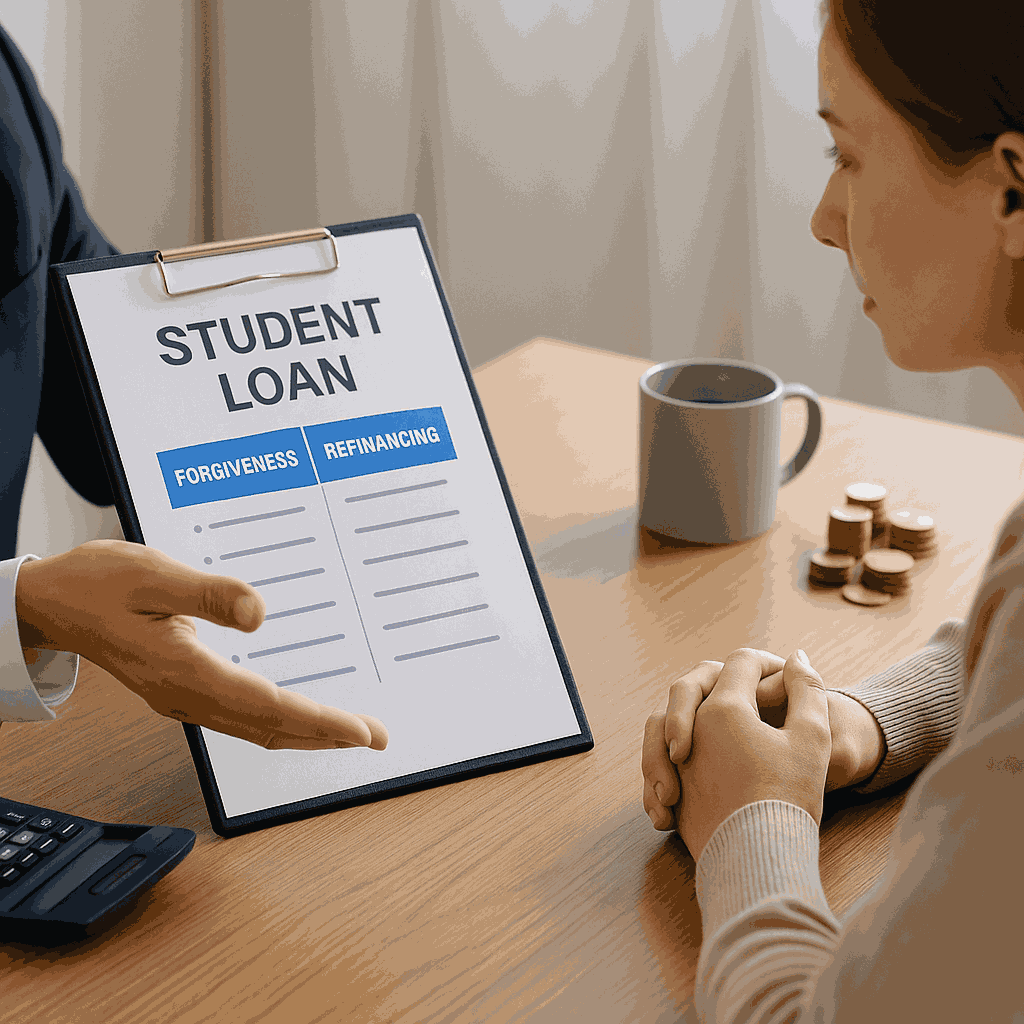
If you’re carrying student loans in 2025, chances are you’ve seen headlines about forgiveness programs, payment pauses, and refinancing offers. But what’s really best for your wallet?
Should you stick with a federal plan in hopes of loan forgiveness—or refinance for a lower interest rate and pay off faster?
Let’s walk through the updated student loan forgiveness vs. refinancing landscape in 2025, how new rules impact your options, and how to choose the smartest path forward.
Student Loan Landscape in 2025: What’s New?
After years of pandemic relief and multiple policy changes, student loan repayment resumed in late 2023. But in 2025, new rules are in full effect:
- The SAVE Plan (replaces REPAYE) caps payments at 5% of discretionary income for many borrowers
- Automatic forgiveness for some who’ve been paying 20+ years under income-driven plans
- New PSLF waivers still apply to many public service workers
- Interest is back in full swing—no more zero percent
That means borrowers now must choose wisely between sticking with federal protections or seeking lower interest rates through private lenders.
What Is Student Loan Forgiveness?
Student loan forgiveness is when part (or all) of your federal loan balance is wiped away—usually after meeting certain criteria.
Main types in 2025 include:
1. Public Service Loan Forgiveness (PSLF)
Forgives your remaining balance after 120 monthly payments while working for a qualified employer (e.g., government, non-profit)
2. Income-Driven Repayment (IDR) Forgiveness
Forgives your balance after 20–25 years of qualifying payments on plans like SAVE or IBR
3. Teacher Loan Forgiveness
Offers up to $17,500 in forgiveness for teachers in low-income schools
4. Borrower Defense & Closed School Discharges
Forgiveness for those defrauded by schools or if your college shuts down
5. SAVE Plan Automatic Forgiveness
New borrowers with original balances under $12,000 may see full forgiveness after just 10 years of payments under SAVE
Pros of Student Loan Forgiveness
- Keeps you in the federal system (payment pauses, hardship forbearance, flexible options)
- Tax-free forgiveness under PSLF and IDR (until at least 2026)
- No need for perfect payment history (with PSLF waiver reforms)
Cons of Student Loan Forgiveness
- Takes time—10 to 25 years depending on program
- Requires strict eligibility (employment, consistent income updates)
- Missed payments or job changes can disqualify you
- Balance may grow over time if payments are too low
Forgiveness works best if you qualify for PSLF or don’t expect to repay the full amount anyway.
What Is Student Loan Refinancing?
Refinancing means replacing your current student loans with a new loan—usually from a private lender at a lower interest rate.
When you refinance:
- You lose access to federal benefits like PSLF, IDR, deferment
- You lock into a fixed or variable rate with set monthly payments
- You can choose terms from 5 to 20 years
Popular refinancing lenders in 2025:
- SoFi
- Laurel Road
- Earnest
- Credible
- Citizens Bank
Pros of Refinancing
- Lower interest rate (sometimes 4% or less with excellent credit)
- Shorter loan term = faster payoff
- Better for high earners who don’t qualify for forgiveness
- One simple monthly payment
Cons of Refinancing
- You lose federal protections forever
- No forgiveness eligibility
- Requires good to excellent credit (usually 680+)
- Private loans aren’t dischargeable in most hardship cases
Refinancing works best for those with stable income, strong credit, and no plans to rely on federal forgiveness.
Table: Forgiveness vs. Refinancing at a Glance
| Feature | Forgiveness Programs | Refinancing |
|---|---|---|
| Best for | Low/moderate earners, public workers | High earners, stable jobs |
| Time to payoff | 10–25 years | 5–15 years |
| Tax on forgiveness | Usually none (2025) | N/A |
| Interest savings | Moderate | High (with low rate) |
| Federal benefits | ✅ Yes | ❌ No |
| Credit needed | None | 680+ preferred |
When You Should Stick with Forgiveness
You’re likely better off with forgiveness if:
- You work for a non-profit or government employer (PSLF eligible)
- You earn less than $60,000/year
- You have more than $40,000 in federal loans
- You’re on SAVE, IBR, or PAYE and qualify for low payments
- You might need hardship forbearance
Even if you make payments for years, any remaining balance could be wiped clean tax-free—especially if Congress extends current tax policies.
When Refinancing Makes Sense
Refinancing may be a smart move if:
- You have private loans (not eligible for forgiveness)
- You have federal loans but make over $100K/year and don’t qualify for PSLF
- Your credit score is 700+ and you qualify for a lower interest rate
- You want to pay off debt faster and save on interest
Bonus Tip: If you have both federal and private loans, consider refinancing only the private ones first. Keep your federal loans eligible for forgiveness.
Pie Chart: Common Borrower Profiles in 2025
- 40% using SAVE or IBR
- 25% pursuing PSLF
- 20% considering refinancing
- 10% in deferment or forbearance
- 5% discharged or forgiven already
Final Thoughts
Student loan forgiveness gives long-term relief—especially for those with modest incomes or nonprofit jobs. Refinancing, on the other hand, delivers faster results for those who can afford to repay quickly and want better interest rates.
The smartest move? Do the math, run real payoff estimates, and stay informed as rules shift.
Because in 2025, your loan strategy is just as important as your loan itself.